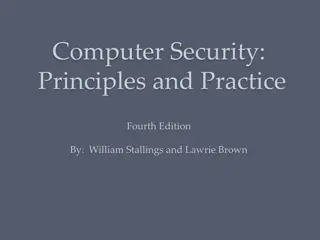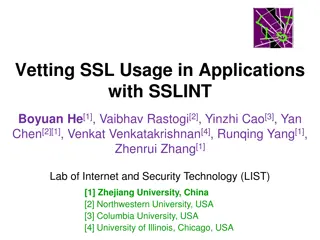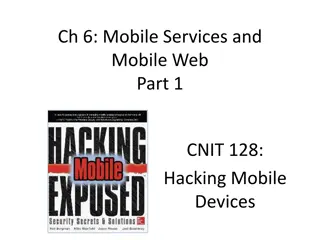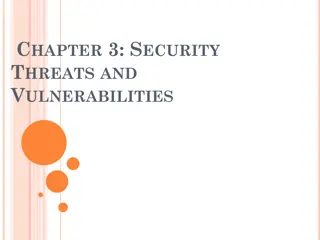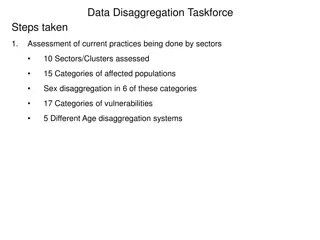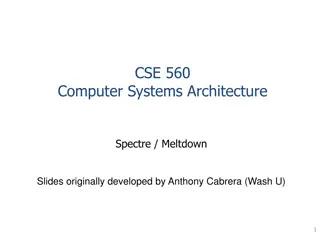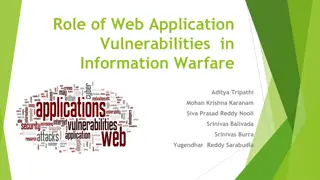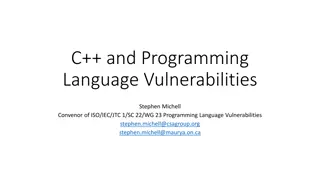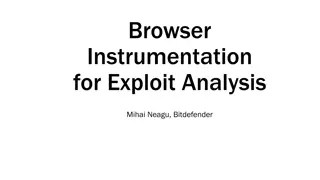Understanding EternalBlue Exploit: History, Vulnerabilities, and Impact
EternalBlue is a notorious exploit developed by the NSA and leaked by the Shadow Brokers hacker group. It has been used in significant cyberattacks like WannaCry and NotPetya, targeting Windows systems through SMB protocol vulnerabilities. This exploit's impact and the various attacks it has been utilized in showcase the critical need for cybersecurity awareness and protection.
Download Presentation

Please find below an Image/Link to download the presentation.
The content on the website is provided AS IS for your information and personal use only. It may not be sold, licensed, or shared on other websites without obtaining consent from the author. Download presentation by click this link. If you encounter any issues during the download, it is possible that the publisher has removed the file from their server.
E N D
Presentation Transcript
Timeline Before: It is discovered and developed by the NSA (U.S. National Security Agency) April 14, 2017: it is released into by the Shadow Brokers hacker group https://github.com/misterch0c/shadowbroker April 24, 2017: it is used by Adylkuzz a botnet cryptominer that puts a bot on your computer to mine Monero coin May 12, 2017: it is used in the WannaCry ransomware A ransomware that encrypted the files on a victim s computer and would only be decrypted if a ransom is paid
contd June 27, 2017: it is used in the NotPetya attack A ransomware that would load on boot and tell the user to pay otherwise their files would be wiped September 22, 2017: Retefe the banking Trojan adds a component that uses EternalBlue October, 2017: WannaMine uses EternalBlue as a part of how it gets into Windows computers March 20, 2017: This presentation
How was EternalBlue used EternalBlue targets a vulnerability in the SMB protocol to get into Windows though port 445 or TCP WannaCry would randomly check IP addresses over a LAN about 25 address/second to find other computers with port 445 open The attacks would use EternalBlue to self-propagate
Server Message Block (SMB) It uses multiple ports, but port 445 is used for file sharing over TCP For a SMB message requires is sent there is a max buffer size for a message and when it is greater than this, the rest of the message is sent as a Secondary Trans 2 request The SMB protocol is used for file sharing over a network by Windows
Secondary Trans2 Request There are two functions that handle the packets being sent SMB_COM_NT_TRANSACT SMB_COM_TRANSACTION2 The secondary part is when it exceeds the SMB MaxBufferSize and these have their own functions that split up the packets SMB_COM_NT_TRANSACT_SECONDARY SMB_COM_TRANSACTION2_SECONDARY
Lets dive into EternalBlue 1. Wrong casting 2. Wrong Parsing Function 3. Non-paged pool allocation 3 main bugs behind the exploit
Wrong casting Word (unsigned int): Max value: 0xffff ~ 2^16 DWord (signed int): Max value: 0xffffffff ~ 2^32 A packet has the SMB header, and a list of file extended attributes (Fea) for data Fea, are a key value pair with attribute name: attribute value SrvOs2FeaListSizetoNT: Will recalculate the OS2Fea->SizeOfListInBytes variable
Now the list is smaller and can fit the data into a packet Now here rather than shrinking it, the size increased
Wrong Parsing Function If SMB_COM_NT_TRANSACT ION2_SECONDARY is called after SMB_COM_NT_TRANSACT Since SMB_COM_NT_TRANSACT handles larger values (DWord) then the packet will be parsed as a Word by SMB_COM_NT_TRANSACTION2_SECONDARY Looking back at bug 1, that extra part is now ignored leaving it on the heap There are no check to see if SMB_COM_NT_TRANSACTION2 or SMB_COM_NT_TRANSACT is called first Together this causes an out of bounds (OOB) write
Non-paged pool allocation Non-paged pool Where Window stores objects for processes, threads, mutexes, etc It has certain rules that when broken cause a IRQL_NOT_LESS_OR_EQUAL error that can crash your computer There s a certain bug that when you want to setup the session and send it as extended security, the flag for extended security won t be turned on and the bytesize is wrong cause there to be a hole in the memory Using these 3 bugs we will get a buffer overrun
Quick Review of Buffer Overrun Make a buffer that will push the stack Overwrite the return address with a new location in memory, which contains your shellcode Buffer Overrun on the stack
Heap Buffer Overrun Heap Spraying You put a pointer to the shellcode within chunks of data filled with nops so that it is pushed towards something useful that is run within the heap These chunks are then put all over the heap Once this computer starts trying to read this pointer, the shellcode does it s thing and is the same as a stack overrun
How is it used in EternalBlue There is a srvnet struct that is used and when closed will run a handler function So the pool is sprayed with these srvnet structs by opening multiple connections, this increases our chances of getting a overrun Once the hole is created somewhere in the pool, it will leave space for the OS2Fea and NTFea conversion to fill up and overwrite one of the srvnet structs and change it s handler function to our shellcode
This is what EternalBlue is So now let s take a look at the actual Overrun Thanks to metasploit/rapid7 and ElevenPaths https://github.com/rapid7/metasploit- framework/blob/master/modules/exploits/windows/smb/ms17_010_eternalblue.rb https://github.com/ElevenPaths/Eternalblue-Doublepulsar-Metasploit Let s take a look at what happens when we run wireshark and run the exploit BufferOverun using the SMB protocol
Mitigation DoublePulsar check: https://github.com/countercept/doublepulsar-detection- script It has been patched, so keep Windows updated Disable SMB and close port 445 Eternal Blues: http://omerez.com/eternalblues/
Sources https://www.fireeye.com/blog/threat-research/2017/06/petya-ransomware-spreading-via-eternalblue-exploit.html https://www.fireeye.com/blog/threat-research/2017/05/threat-actors-leverage-eternalblue-exploit-to-deliver-non-wannacry-payloads.html https://www.fireeye.com/blog/threat-research/2018/02/cve-2017-10271-used-to-deliver-cryptominers.html https://www.fireeye.com/blog/threat-research/2017/05/wannacry-malware-profile.html https://www.scmagazine.com/eternalblue-used-in-wannacry-now-with-nitol-backdoor-and-gh0st-rat/article/666426/ https://isc.sans.edu/forums/diary/ETERNALBLUE+Windows+SMBv1+Exploit+Patched/22304/ http://www.wired.co.uk/article/what-is-eternal-blue-exploit-vulnerability-patch https://www.rapid7.com/db/modules/exploit/windows/smb/ms17_010_eternalblue https://www.fireeye.com/blog/threat-research/2017/05/smb-exploited-wannacry-use-of-eternalblue.html https://www.fireeye.com/blog/products-and-services/2017/05/wannacry-ransomware-campaign.html https://msdn.microsoft.com/en-us/library/windows/desktop/aa365233(v=vs.85).aspx https://support.microsoft.com/en-ca/help/2696547/how-to-detect-enable-and-disable-smbv1-smbv2-and-smbv3-in-windows-and https://en.wikipedia.org/wiki/Server_Message_Block https://blog.skyboxsecurity.com/top-malware-in-2018-what-to-watch-for/ https://www.cisecurity.org/top-10-malware-january-2018/ https://www.theinquirer.net/inquirer/news/3025754/nsa-leaked-hack-eternalblue-back-and-powering-wannamine-cryptojacking-malware https://blog.malwarebytes.com/cybercrime/2017/05/how-did-wannacry-ransomworm-spread/ https://en.wikipedia.org/wiki/Heap_spraying https://isc.sans.edu/forums/diary/WannaCryWannaCrypt+Ransomware+Summary/22420 https://github.com/misterch0c/shadowbroker/blob/master/windows/specials/Eternalblue-2.2.0.0.xml https://support.microsoft.com/en-us/help/2696547/how-to-detect-enable-and-disable-smbv1-smbv2-and-smbv3-in-windows-and https://wiki.wireshark.org/SMB2 https://research.checkpoint.com/eternalblue-everything-know/ https://github.com/rapid7/metasploit-framework/blob/master/modules/exploits/windows/smb/ms17_010_eternalblue.rb http://resources.infosecinstitute.com/heap-overflow-vulnerability-and-heap-internals-explained/#gref





